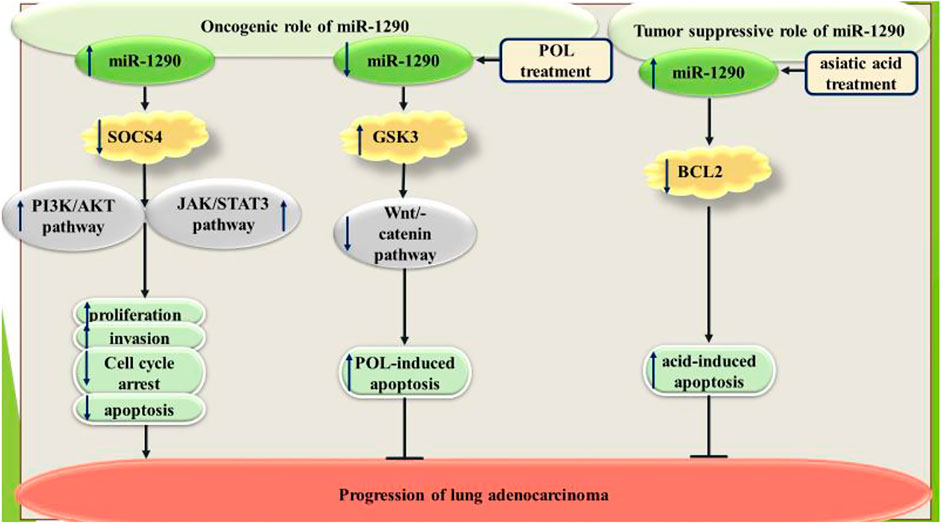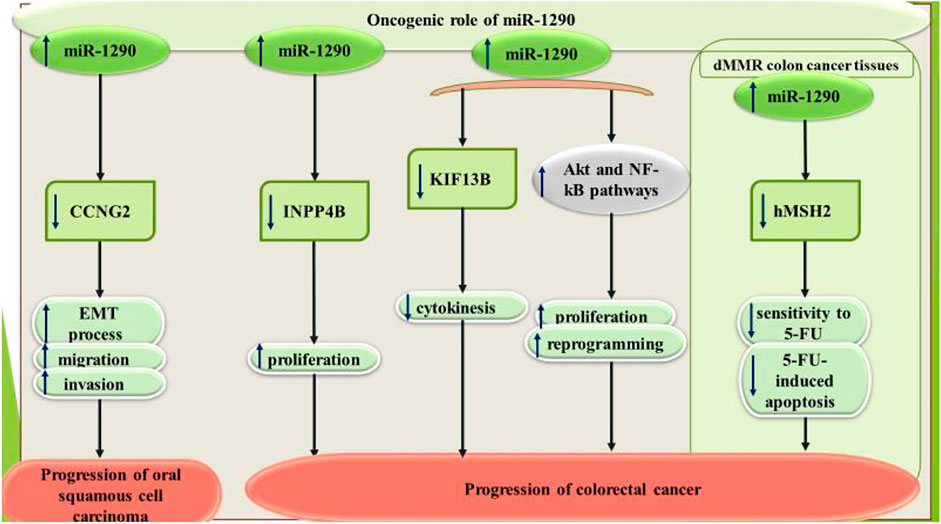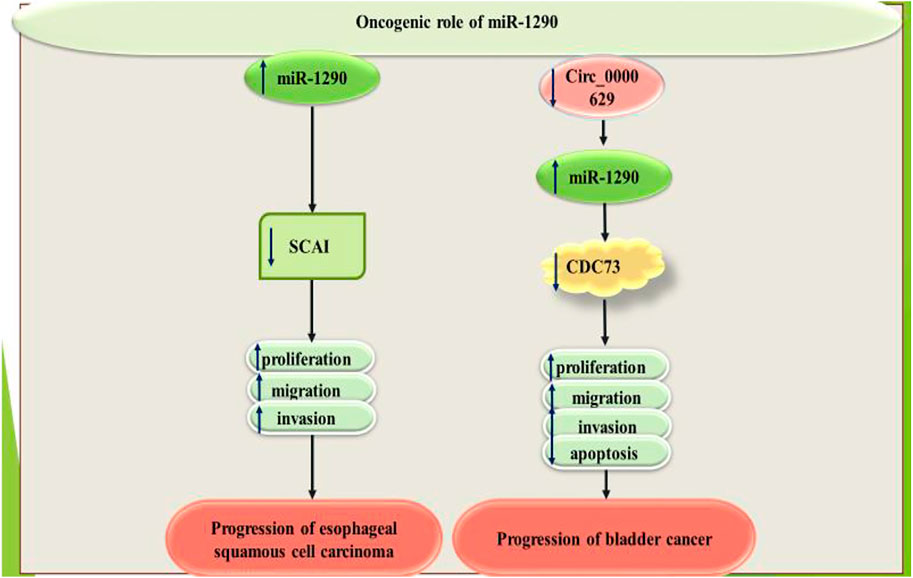- 1Department of Medical Genetics, School of Medicine, Shahid Beheshti University of Medical Sciences, Tehran, Iran
- 2Men’s Health and Reproductive Health Research Center, Shahid Beheshti University of Medical Sciences, Tehran, Iran
- 3Department of Pharmacognosy, College of Pharmacy, Hawler Medical University, Kurdistan Region, Iraq
- 4Urology and Nephrology Research Center, Shahid Beheshti University of Medical Sciences, Tehran, Iran
- 5Institute of Human Genetics, Jena University Hospital, Jena, Germany
- 6Skull Base Research Center, Loghman Hakim Hospital, Shahid Beheshti University of Medical Sciences, Tehran, Iran
MicroRNAs (miRNAs) have been shown to affect expression of several genes contributing in important biological processes. miR-1290 a member of this family with crucial roles in the carcinogenesis. This miRNA is transcribed from MIR1290 gene on chromosome 1p36.13. This miRNA has interactions with a number of mRNA coding genes as well as non-coding RNAs SOCS4, GSK3, BCL2, CCNG2, KIF13B, INPP4B, hMSH2, KIF13B, NKD1, FOXA1, IGFBP3, CCAT1, FOXA1, NAT1, SMEK1, SCAI, ZNF667-AS1, ABLIM1, Circ_0000629 and CDC73. miR-1290 can also regulate activity of JAK/STAT3, PI3K/AKT, Wnt/β-catenin and NF-κB molecular pathways. Most evidence indicates the oncogenic roles of miR-1290, yet controversial evidence also exists. In the present review, we describe the results of in vitro, animal and human investigations about the impact of miR-1290 in the development of malignancies.
Introduction
MicroRNAs (miRNAs) are a group of small-sized transcripts with a wide range of regulatory roles. They are mostly produced through a multistep mechanism. These steps include transcription from DNA sequences into primary miRNAs and processing into precursor miRNAs and subsequently into mature miRNAs. The majority of bind with the 3′ untranslated region (3′ UTR) of target transcripts to either degrade mRNA or repress its translation. In some circumstances, miRNAs can induce translation or control transcription (O'Brien et al., 2018). Approximately 50% of all miRNAs are transcribed from intragenic regions. These miRNAs are mainly produced from introns and a number of exons of protein coding genes. Other miRNAs are intergenic and are produced in an independent manner from a host gene. Thus, these miRNAs have their own promoters (Kim and Kim, 2007; De Rie et al., 2017). miRNAs partake in the regulation of important biological functions, such as cell proliferation, differentiation and apoptosis, thus being involved in the pathoetiology of several disorders, particularly neoplastic disorders (Peng and Croce, 2016). These transcripts participate in the pathoetiology of diverse cancers (Abolghasemi et al., 2020).
miR-1290 is transcribed from MIR1290 gene on chromosome 1p36.13. The primary transcript (NR_031622.1) has 78 nucleotides (GAGCGUCACGUUGACACUCAAAAAGUUUCAGAUUUUGGAACAUUUCGGAUUUUGGAUUUUUGGAUCAGGGAUGCUCAA). The mature transcript of hsa-miR-1290 (MIMAT0005880) has 19 nucleotides (UGGAUUUUUGGAUCAGGGA). This miRNA has important functions in the carcinogenesis. Several in vitro studies have assessed function of miR-1290. Moreover, animal studies in lung, colon and liver cancer models have assessed functional consequences of up-regulation or silencing of this miRNA. However, some inconsistencies exist regarding the role of miR-1290. In the present manuscript, we describe the results of in vitro, animal and human assays about the influence of miR-1290 in the development of cancers.
In vitro Studies
Forced over-expression of miR-1290 in AsPC1 and Panc5.04 pancreatic cancer cell lines has led to enhancement of cell proliferation. Inhibition of miR-1290 in pancreatic cancer cells has the reverse effects. miR-1290 mimics have also enhanced invasive properties of these cells (Li et al., 2013).
Over-expression of miR-1290 has enhanced proliferation of proliferation of lung adenocarcinoma cells and induced cell cycle progression and invasiveness. Moreover, this miRNA has suppressed cell apoptosis in this cell line. miR-1290 has been found to downregulate expression of SOCS4 to activate JAK/STAT3 and PI3K/AKT pathways (Xiao et al., 2018).
The anti-proliferative and apoptosis-inducing agent polygonatum odoratum lectin (POL) has been shown to decrease miR-1290 levels in A549 lung adenocarcinoma cells. Down-regulation of miR-1290 has been shown to increase POL-associated apoptosis in these cells. GSK3β has been found as the direct target of miR-1290 in A549 cells (Wu et al., 2016). Conversely, miR-1290 has been shown to sensitize A549 cells to the apoptosis-inducing agent asiatic acid through negatively regulating expression of BCL2. Expression of miR-1290 has been up-regulated by asiatic acid. Most notably, the apoptosis-inducing effect of asiatic acid relies on miR-1290 activity. Taken together, miR-1290 has been shown to suppress viability and cell cycle progression of A549 cells (Kim et al., 2014). Figure 1 summarizes the effects of miR-1290 in the pathoetiology of lung cancer.
In oral squamous cell carcinoma, miR-1290 has been shown to be up-regulated parallel with downregulation of CCNG2. miR-1290 silencing has inhibited metastatic ability and epithelial-mesenchymal transition (EMT). CCNG2 has been identified as the direct target of miR-1290 (Qin et al., 2019). Functional studies in laryngeal squamous cell carcinoma has shown that miR-1290 targets two tumor suppressor genes, namely ITPR2 and MAF (Janiszewska et al., 2015).
miR-1290 has oncogenic roles in colorectal cancer. miR-1290 silencing has suppressed proliferation of colorectal cancer cells. miR-1290 up-regulation has decreased expression of p27 and enhanced transcript and protein amounts of cyclin D1. NPP4B has been recognized as the target of miR-1290 (Ma et al., 2018). Moreover, miR-1290 silencing has improved cytotoxic effects of 5-fluouracil in colorectal cancer cells through targeting hMSH2 (Ye et al., 2017). Figure 2 shows the oncogenic role of miR-1290 in squamous cell carcinoma and colorectal cancer.
Exosomal miR-1290 has been found to be high in gastric cancer cell lines. miR-1290-containing exosomes could promote proliferation, migratory aptitude, and invasiveness of gastric cancer cells. NKD1 has been identified as the direct target of miR-1290 in these cells (Huang et al., 2019). Moreover, miR-1290 has been revealed to increase proliferation and migratory aptitude of gastric cancer cells through targeting FOXA1 (Lin et al., 2016).
miR-1290 has also been shown to be overexpressed in B-acute lymphoblastic leukemia (ALL) cell line SUP-B15. The anticancer agent resveratrol has been found to down-regulate expression of miR-1290 and enhance IGFBP3 levels in the ALL cells. miR-1290 can target 3′ UTR of IGFBP3 (Zhou et al., 2017). Besides, exosomal miR-1290 has been demonstrated to promote angiogenic processes in hepatocellular carcinoma through influencing expression of SMEK1 (Wang et al., 2021c).
On the other hand, miR-1290 has been shown to exert tumor suppressive role in ovarian cancer. In fact, the oncogenic long non-coding RNA (lncRNA) CCAT1 facilitates ovarian carcinogenesis through decreasing miR-1290 levels (Lai and Cheng, 2018).
Figure 3 shows the roles of miR-1290 in gastric cancer, ALL, hepatocellular carcinoma and ovarian cancer.
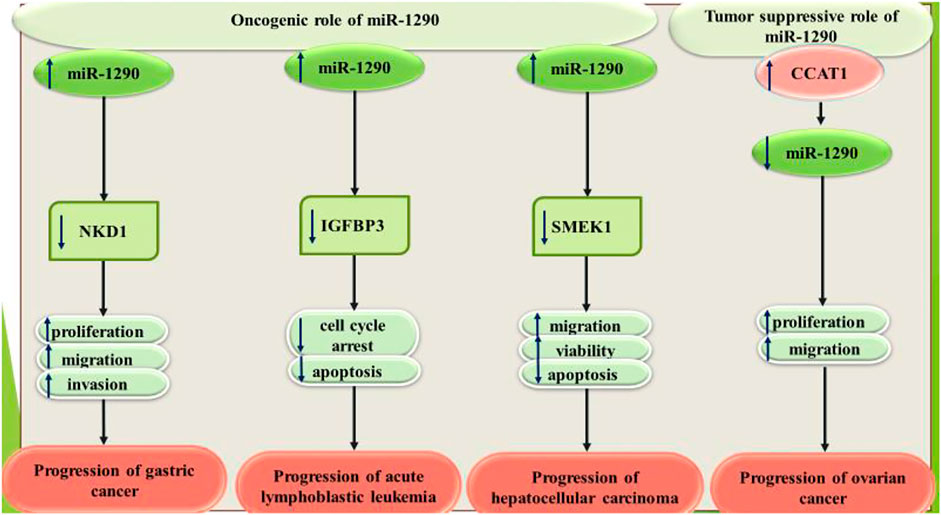
FIGURE 3. miR-1290 has oncogenic roles in gastric cancer, acute lymphoblastic leukemia and hepatocellular carcinoma, while it has tumor suppressive roles in ovarian cancer.
Over-expression of miR-1290 has enhanced esophageal squamous cell carcinoma growth, migration and invasiveness through decreasing SCAI levels (Li et al., 2015). In bladder cancer cells, tumor suppressor Circular RNA circ_0000629 has been shown to exert its effects through suppressing miR-1290 levels and up-regulating CDC73 expression (Wang et al., 2021b). Figure 4 shows the oncogenic role of miR-1290 in esophageal and bladder cancers.
Summary of in vitro studies regarding the role of miR-1290 in the carcinogenesis is provided in Table 1.
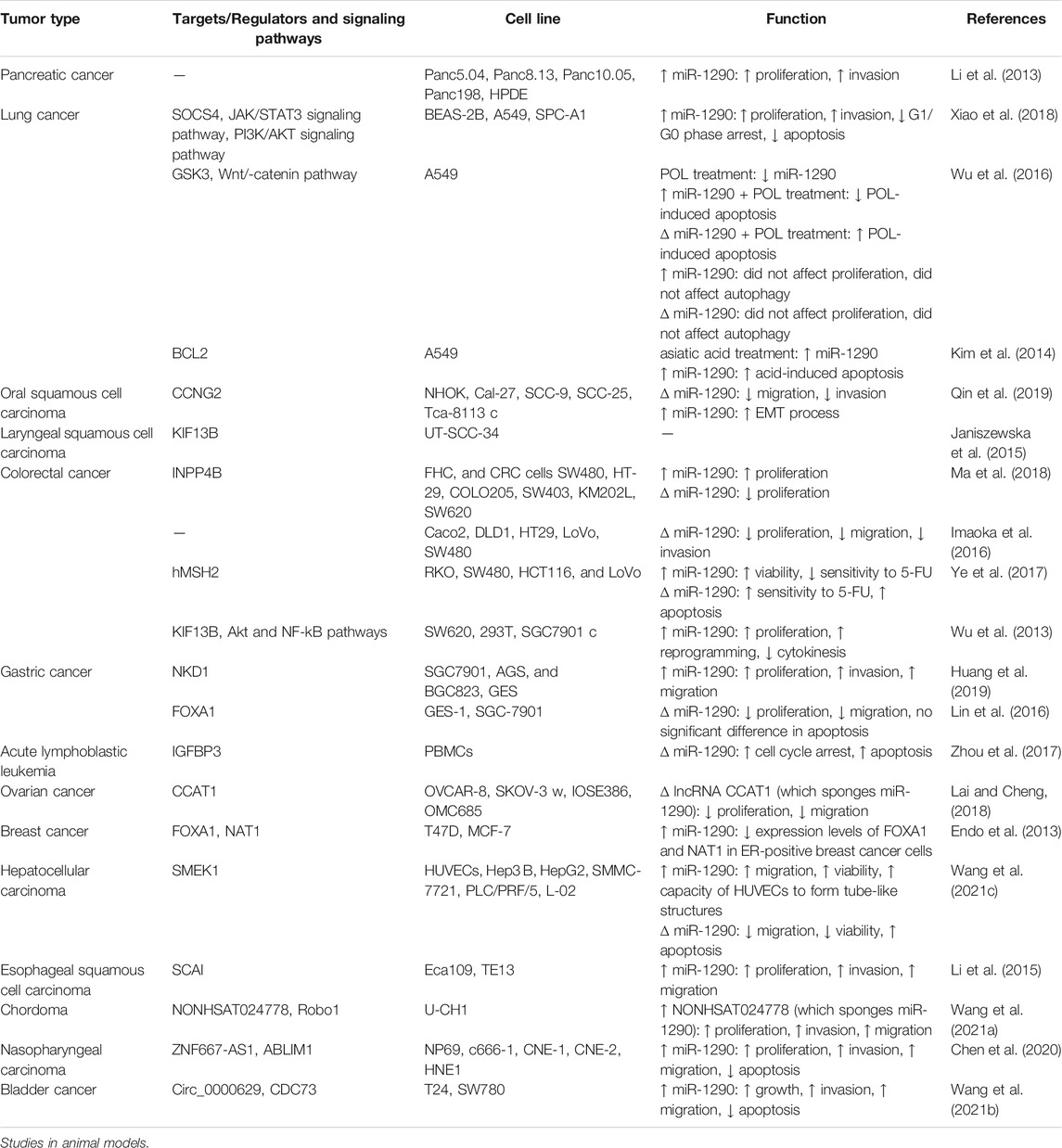
TABLE 1. Expression pattern of miR-1290 in cancer cell lines (∆: knock-down or deletion, POL: Polygonatum odoratum lectin, 5-FU: 5-Fluorouracil).
miRNA-1290 has important roles in determination of response of cancer cells to 5-fluouracil. miR-1290 silencing has improved cytotoxic effects of 5-fluouracil in xenografts models of this cancer via targeting hMSH2 (Ye et al., 2017). Other studies have shown oncogenic roles of miR-1290 in animal models of lung cancer (Xiao et al., 2018), hepatocellular carcinoma (Wang et al., 2021c) and nasopharyngeal carcinoma (Chen et al., 2020) (Table 2). On the other hand, animal studies have shown that the oncogenic lncRNA NONHSAT024778 acts through sponging miR-1290, thus revealing a tumor suppressor role for miR-1290 (Wang et al., 2021a).

TABLE 2. Impact of miR-1290 in carcinogenesis based on investigations in animal models (∆: knock-down or deletion).
Studies in Clinical Samples
In lung adenocarcinoma tissues, expression of miR-1290 has been negatively correlated with SOCS4 levels. Expression of SOCS4 has been inversely correlated with higher clinical stages and lymph node metastases (Xiao et al., 2018). Moreover, miR-1290 levels have been associated with clinicopathological landscapes and poor prognosis of patients with oral squamous cell carcinoma (Qin et al., 2019). In laryngeal squamous cell carcinoma, a high throughput miRNA profiling experiment has shown up-regulation of 33 miRNAs, among them being miR-1290 (Janiszewska et al., 2015).
Comparison of miRNA profiles between deficient and proficient mismatch repair colon cancer tissues has shown up-regulation of miR-1290 in deficient mismatch repair colorectal cancer tissues. Expression of miR-1290 has been correlated with poor prognoses of colon cancer in stages II and III patients who took 5-fluouracil-based chemotherapeutics regimens (Ye et al., 2017).
miR-1290 has also been exhibited to be up-regulated in serum exosomes of gastric cancer patients compared with healthy people (Huang et al., 2019). Another study in gastric cancer patients has shown correlation between miR-1290 over-expression and clinical stage, deepness of invasion and lymph node positivity (Lin et al., 2016).
miR-1290 has also been shown to be upregulated in esophageal squamous cell carcinoma tissues compared with unaffected neighboring samples. Over-expression of miR-1290 has been associated with level of differentiation, N classification TNM stage in this type of esophageal cancer (Li et al., 2015).
On the other hand, in oral squamous cell carcinoma, levels of this miRNA has been reported to be decreased in blood samples of patients compared with control samples (Nakashima et al., 2019). Moreover, expression of miR-1290 has been reported to be decreased in chordoma samples (Wang et al., 2021a). Table 3 summarizes the results of studies that reported dysregulation of miR-1290 in clinical samples.

TABLE 3. Dysregulation of miR-1290 in clinical specimens (DC: benign pancreatic disease controls, PFS: progression free survival, LUAD: Lung adenocarcinoma, ANCTs: adjacent non-cancerous tissues, OS: Overall survival, DFS: disease-free survival, TNM: tumor-node-metastasis, NSCLC: non-small-cell lung cancer, CRA: colorectal adenoma, HGSOC: high grade serous ovarian cancer, EOC: epithelial ovarian cancer, HGSOC: high grade serous ovarian carcinoma.).
Serum levels of miR-1290 have been shown to be higher in patients with intraductal papillary mucinous pancreatic cancer compared with healthy subjects. The ability of serum levels of miR-1290 in separation of patients with low-stage pancreatic cancer from controls has been higher than CA19-9. Notably, higher levels of miR-1290 has been predictive of poor outcome following pancreaticoduodenectomy (Li et al., 2013). In this type of cancer, miR-1290 has been shown to appropriately distinguish neoplastic condition from both healthy condition and chronic pancreatitis (Wei et al., 2020). In colorectal cancer, levels of this miRNA could distinguish cancer status from healthy condition with up to ideal diagnostic power. Moreover, it can separate colorectal adenoma from healthy status with lower values (Imaoka et al., 2016). Table 4 shows the diagnostic value of miR-1290 in cancers.
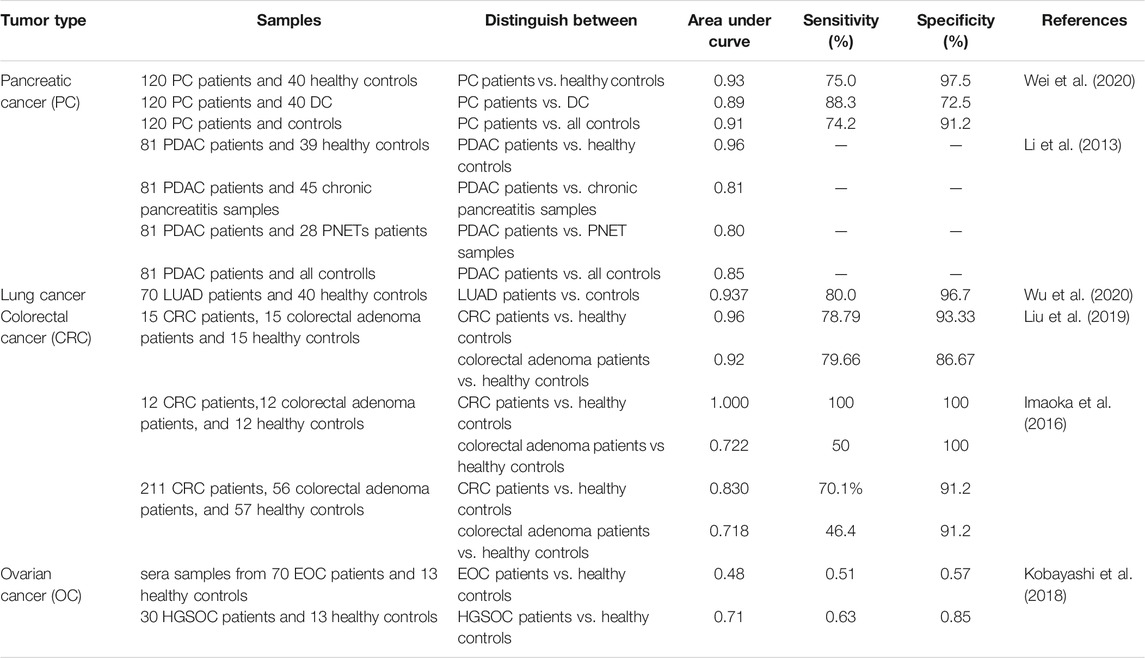
TABLE 4. Diagnostic value of miR-1290 in cancers (PC: pancreatic cancer; DC: benign pancreatic disease control; LUAD: Lung adenocarcinoma, EOC: epithelial ovarian cancer, HGSOC: high grade serous ovarian carcinoma).
Discussion
Several miRNAs have been found to influence the carcinogenesis. miR-1290 is an example of oncomiRs based on the bulk of relevant evidence. This miRNA has interactions with several cancer-related mRNAs such as SOCS4, GSK3, BCL2, CCNG2, KIF13B, INPP4B, hMSH2, KIF13B, NKD1, FOXA1, IGFBP3, FOXA1, NAT1, SMEK1, SCAI, ZNF667-AS1, ABLIM1, and CDC73.
Moreover, miR-1290 has interactions with a number of non-coding RNAs such as Circ_0000629, CCTA1 and NONHSAT024778. The interaction between lncRNAs/circRNAs and miRNAs has important implications in pathoetiology of cancers, thus future studies are needed to identify other non-coding RNAs that interact with miR-1290 in the context of neoplastic conditions. In fact, these lncRNAs and circRNAs can act as sponge for miRNAs to decrease its bioavalability, thus enhancing expression of targets of miR-1290. Therefore, they construct a competing endogenous RNA (ceRNA) network.
In addition to its role in the regulation of gene expression, miR-1290 can regulate activity of JAK/STAT3, PI3K/AKT, Wnt/β-catenin and NF-κB signaling pathways, thus influencing several cancer-related routes.
Most evidence indicates the oncogenic roles of miR-1290, yet controversial evidence also exists. Particularly, in the lung cancer, both oncogenic and tumor suppressor roles have been reported for miR-1290.
A number of anticancer agents such as POL, asiatic acid and resveratrol has been shown to affect expression of miR-1290. Moreover, this miRNA can influence response of neoplastic cells to the chemotherapeutic agent 5-fluouracil. Thus, one can deduce that miR-1290-targeting strategies can modulate response of cancer cells to a wide variety of antineoplastic modalities.
In addition to its therapeutic implications, the existence of miR-1290 in cancer-derived exosomes not only indicates its application in diagnostic approaches, but also shows the effect of these vehicles in conferring neoplastic features inside the tumor bulk.
The ceRNA networks constructed by circRNAs, miR-1290 and target mRNAs can be used as prognostic biomarkers and therapeutic targets in different cancers. These ceRNA networks are superior to single transcripts since they reflect a more comprehensive overview of dysregulated pathways. Theoretically, the ceRNA regulatory networks including lncRNAs or circRNAs-miR-1290-mRNAs can be applied as prognostic biomarkers and therapeutic targets in different cancers. High throughput sequencing methods have facilitated applicability of these networks in diagnostic, prognostic and therapeutic fields. Moreover, these techniques have facilitated design of personalized therapeutic options based on the identified dysregulated networks in samples obtained from each patient. Application of this data can enhance survival of patients.
Cumulatively, miR-1290 is a cancer-related miRNA with possible application as diagnostic and prognostic marker in diverse types of cancers. Therapeutic applications of anti-miR-1290 modalities should be assessed in future. Moreover, future studies should address the possibility of targeting the miR1290-containg ceRNA networks.
Author Contributions
SG-F wrote the draft and revised it. MT designed and supervised the study. TK and MS collected the data and designed the figures and tables. All the authors read and approved the submitted version.
Conflict of Interest
The authors declare that the research was conducted in the absence of any commercial or financial relationships that could be construed as a potential conflict of interest.
Publisher’s Note
All claims expressed in this article are solely those of the authors and do not necessarily represent those of their affiliated organizations, or those of the publisher, the editors and the reviewers. Any product that may be evaluated in this article, or claim that may be made by its manufacturer, is not guaranteed or endorsed by the publisher.
References
Abolghasemi, M., Tehrani, S. S., Yousefi, T., Karimian, A., Mahmoodpoor, A., Ghamari, A., et al. (2020). MicroRNAs in Breast Cancer: Roles, Functions, and Mechanism of Actions. J. Cell Physiol 235, 5008–5029. doi:10.1002/jcp.29396
Chen, X., Huang, Y., Shi, D., Nie, C., Luo, Y., Guo, L., et al. (2020). LncRNA ZNF667-AS1 Promotes ABLIM1 Expression by Adsorbing microRNA-1290 to Suppress Nasopharyngeal Carcinoma Cell Progression. Ott 13, 4397–4409. doi:10.2147/ott.s245554
De Rie, D., Abugessaisa, I., Abugessaisa, I., Alam, T., Arner, E., Arner, P., et al. (2017). An Integrated Expression Atlas of miRNAs and Their Promoters in Human and Mouse. Nat. Biotechnol. 35, 872–878. doi:10.1038/nbt.3947
Endo, Y., Toyama, T., Takahashi, S., Yoshimoto, N., Iwasa, M., Asano, T., et al. (2013). miR-1290 and its Potential Targets Are Associated with Characteristics of Estrogen Receptor α-positive Breast Cancer. Endocrine-related cancer 20, 91–102. doi:10.1530/erc-12-0207
Geusau, A., Borik-Heil, L., Skalicky, S., Mildner, M., Grillari, J., Hackl, M., et al. (2020). Dysregulation of Tissue and Serum microRNAs in Organ Transplant Recipients with Cutaneous Squamous Cell Carcinomas. Health Sci. Rep. 3, e205. doi:10.1002/hsr2.205
Handa, T., Kuroha, M., Nagai, H., Shimoyama, Y., Naito, T., Moroi, R., et al. (2021). Liquid Biopsy for Colorectal Adenoma: Is the Exosomal miRNA Derived from Organoid a Potential Diagnostic Biomarker? Clin. Transl Gastroenterol. 12, e00356. doi:10.14309/ctg.0000000000000356
Huang, J., Shen, M., Yan, M., Cui, Y., Gao, Z., and Meng, X. (2019). Exosome-mediated Transfer of miR-1290 Promotes Cell Proliferation and Invasion in Gastric Cancer via NKD1. Acta Biochim. Biophys. Sinica 51, 900–907. doi:10.1093/abbs/gmz077
Huang, X., Yuan, T., Liang, M., Du, M., Xia, S., Dittmar, R., et al. (2015). Exosomal miR-1290 and miR-375 as Prognostic Markers in Castration-Resistant Prostate Cancer. Eur. Urol. 67, 33–41. doi:10.1016/j.eururo.2014.07.035
Imaoka, H., Toiyama, Y., Fujikawa, H., Hiro, J., Saigusa, S., Tanaka, K., et al. (2016). Circulating microRNA-1290 as a Novel Diagnostic and Prognostic Biomarker in Human Colorectal Cancer. Ann. Oncol. 27, 1879–1886. doi:10.1093/annonc/mdw279
Janiszewska, J., Szaumkessel, M., Kostrzewska-Poczekaj, M., Bednarek, K., Paczkowska, J., Jackowska, J., et al. (2015). Global miRNA Expression Profiling Identifies miR-1290 as Novel Potential oncomiR in Laryngeal Carcinoma. PLoS One 10, e0144924. doi:10.1371/journal.pone.0144924
Kim, K. B., Kim, K., Bae, S., Choi, Y., Cha, H. J., Kim, S. Y., et al. (2014). MicroRNA-1290 Promotes Asiatic Acid-Induced Apoptosis by Decreasing BCL2 Protein Level in A549 Non-small Cell Lung Carcinoma Cells. Oncol. Rep. 32, 1029–1036. doi:10.3892/or.2014.3319
Kim, Y.-K., and Kim, V. N. (2007). Processing of Intronic microRNAs. Embo J. 26, 775–783. doi:10.1038/sj.emboj.7601512
Kobayashi, M., Sawada, K., Nakamura, K., Yoshimura, A., Miyamoto, M., Shimizu, A., et al. (2018). Exosomal miR-1290 Is a Potential Biomarker of High-Grade Serous Ovarian Carcinoma and Can Discriminate Patients from Those with Malignancies of Other Histological Types. J. Ovarian Res. 11, 81–10. doi:10.1186/s13048-018-0458-0
Lai, X. J., and Cheng, H. F. (2018). LncRNA colon Cancer-Associated Transcript 1 (CCAT1) Promotes Proliferation and Metastasis of Ovarian Cancer via miR-1290. Eur. Rev. Med. Pharmacol. Sci. 22, 322–328. doi:10.26355/eurrev_201801_14175
Li, A., Yu, J., Kim, H., Wolfgang, C. L., Canto, M. I., Hruban, R. H., et al. (2013). MicroRNA Array Analysis Finds Elevated Serum miR-1290 Accurately Distinguishes Patients with Low-Stage Pancreatic Cancer from Healthy and Disease Controls. Clin. Cancer Res. 19, 3600–3610. doi:10.1158/1078-0432.ccr-12-3092
Li, H., Zhang, H., Lu, G., Li, Q., Gu, J., Song, Y., et al. (2016). Mechanism Analysis of Colorectal Cancer According to the microRNA Expression Profile. Oncol. Lett. 12, 2329–2336. doi:10.3892/ol.2016.5027
Li, M., He, X.-Y., Zhang, Z.-M., Li, S., Ren, L.-H., Cao, R.-S., et al. (2015). MicroRNA-1290 Promotes Esophageal Squamous Cell Carcinoma Cell Proliferation and Metastasis. Wjg 21, 3245–3255. doi:10.3748/wjg.v21.i11.3245
Li, S., Zhang, M., Xu, F., Wang, Y., and Leng, D. (2021). Detection Significance of miR-3662, miR-146a, and miR-1290 in Serum Exosomes of Breast Cancer Patients. J. Can. Res. Ther. 17, 749. doi:10.4103/jcrt.jcrt_280_21
Lin, M., Shi, C., Lin, X., Pan, J., Shen, S., Xu, Z., et al. (2016). sMicroRNA-1290 Inhibits Cells Proliferation and Migration by Targeting FOXA1 in Gastric Cancer Cells. Gene 582, 137–142. doi:10.1016/j.gene.2016.02.001
Liu, X., Xu, X., Pan, B., He, B., Chen, X., Zeng, K., et al. (2019). Circulating miR-1290 and miR-320d as Novel Diagnostic Biomarkers of Human Colorectal Cancer. J. Cancer 10, 43–50. doi:10.7150/jca.26723
Ma, P., Wang, H., Sun, J., Liu, H., Zheng, C., Zhou, X., et al. (2018). LINC00152 Promotes Cell Cycle Progression in Hepatocellular Carcinoma via miR-193a/b-3p/CCND1 axis. Cell cycle 17, 974–984. doi:10.1080/15384101.2018.1464834
Mo, D., Gu, B., Gong, X., Wu, L., Wang, H., Jiang, Y., et al. (2015). miR-1290 Is a Potential Prognostic Biomarker in Non-small Cell Lung Cancer. J. Thorac. Dis. 7, 1570–1579. doi:10.3978/j.issn.2072-1439.2015.09.38
Nagamitsu, Y., Nishi, H., Sasaki, T., Takaesu, Y., Terauchi, F., and Isaka, K. (2016). Profiling Analysis of Circulating microRNA Expression in Cervical Cancer. Mol. Clin. Oncol. 5, 189–194. doi:10.3892/mco.2016.875
Nakashima, H., Yoshida, R., Hirosue, A., Kawahara, K., Sakata, J., Arita, H., et al. (2019). Circulating miRNA-1290 as a Potential Biomarker for Response to Chemoradiotherapy and Prognosis of Patients with Advanced Oral Squamous Cell Carcinoma: A Single-center Retrospective Study. Tumour Biol. 41, 1010428319826853. doi:10.1177/1010428319826853
O'Brien, J., Hayder, H., Zayed, Y., and Peng, C. (2018). Overview of microRNA Biogenesis, Mechanisms of Actions, and Circulation. Front. Endocrinol. 9, 402. doi:10.3389/fendo.2018.00402
Peng, Y., and Croce, C. M. (2016). The Role of MicroRNAs in Human Cancer. Signal. Transduct Target. Ther. 1, 15004–15009. doi:10.1038/sigtrans.2015.4
Qin, W. J., Wang, W. P., Wang, X. B., Zhang, X. T., and Du, J. D. (2019). MiR-1290 Targets CCNG2 to Promote the Metastasis of Oral Squamous Cell Carcinoma. Eur. Rev. Med. Pharmacol. Sci. 23, 10332–10342. doi:10.26355/eurrev_201912_19671
Sun, X., Song, Y., Tai, X., Liu, B., and Ji, W. (2013). MicroRNA Expression and its Detection in Human Supraglottic Laryngeal Squamous Cell Carcinoma. Biomed. Rep. 1, 743–746. doi:10.3892/br.2013.143
Tavano, F., Gioffreda, D., Valvano, M. R., Palmieri, O., Tardio, M., Latiano, T. P., et al. (2018). Droplet Digital PCR Quantification of miR-1290 as a Circulating Biomarker for Pancreatic Cancer. Sci. Rep. 8, 16389. doi:10.1038/s41598-018-34597-z
Wang, B., Zhang, K., Meng, S., Shao, X., Zhou, Z., Mao, H., et al. (2021a). LncRNA-NONHSAT024778 Promote the Proliferation and Invasion of Chordoma Cell by Regulating miR-1290/Robo1 axis. Int. J. Biol. Sci. 17, 796–806. doi:10.7150/ijbs.54091
Wang, J., Luo, J., Wu, X., and Gao, Z. (2021b). Circular RNA_0000629 Suppresses Bladder Cancer Progression Mediating MicroRNA-1290/CDC73. Cmar 13, 2701–2715. doi:10.2147/cmar.s292863
Wang, Q., Wang, G., Niu, L., Zhao, S., Li, J., Zhang, Z., et al. (2021). Exosomal MiR-1290 Promotes Angiogenesis of Hepatocellular Carcinoma via Targeting SMEK1. J. Oncol., 2021, 1–13. doi:10.1155/2021/6617700
Wei, J., Yang, L., Wu, Y.-N., and Xu, J. (2020). Serum miR-1290 and miR-1246 as Potential Diagnostic Biomarkers of Human Pancreatic Cancer. J. Cancer 11, 1325–1333. doi:10.7150/jca.38048
Wu, J., Ji, X., Zhu, L., Jiang, Q., Wen, Z., Xu, S., et al. (2013). Up-regulation of microRNA-1290 Impairs Cytokinesis and Affects the Reprogramming of colon Cancer Cells. Cancer Lett. 329, 155–163. doi:10.1016/j.canlet.2012.10.038
Wu, L., Liu, T., Xiao, Y., Li, X., Zhu, Y., Zhao, Y., et al. (2016). Polygonatum Odoratum Lectin Induces Apoptosis and Autophagy by Regulation of microRNA-1290 and microRNA-15a-3p in Human Lung Adenocarcinoma A549 Cells. Int. J. Biol. macromolecules 85, 217–226. doi:10.1016/j.ijbiomac.2015.11.014
Wu, Y., Wei, J., Zhang, W., Xie, M., Wang, X., and Xu, J. (2020). Serum Exosomal miR-1290 Is a Potential Biomarker for Lung Adenocarcinoma. Ott 13, 7809–7818. doi:10.2147/ott.s263934
Xiao, X., Yang, D., Gong, X., Mo, D., Pan, S., and Xu, J. (2018). miR-1290 Promotes Lung Adenocarcinoma Cell Proliferation and Invasion by Targeting SOCS4. Oncotarget 9, 11977–11988. doi:10.18632/oncotarget.24046
Yao, T., Rao, Q., Liu, L., Zheng, C., Xie, Q., Liang, J., et al. (2013). Exploration of Tumor-Suppressive microRNAs Silenced by DNA Hypermethylation in Cervical Cancer. Virol. J. 10, 175–177. doi:10.1186/1743-422X-10-175
Ye, L., Jiang, T., Shao, H., Zhong, L., Wang, Z., Liu, Y., et al. (2017). miR-1290 Is a Biomarker in DNA-Mismatch-Repair-Deficient colon Cancer and Promotes Resistance to 5-fluorouracil by Directly Targeting hMSH2. Mol. Ther. - Nucleic Acids 7, 453–464. doi:10.1016/j.omtn.2017.05.006
Keywords: miR-1290, cancer, biomarker, miRNA, expression
Citation: Ghafouri-Fard S, Khoshbakht T, Hussen BM, Taheri M and Samadian M (2021) A Review on the Role of miR-1290 in Cell Proliferation, Apoptosis and Invasion. Front. Mol. Biosci. 8:763338. doi: 10.3389/fmolb.2021.763338
Received: 23 August 2021; Accepted: 24 November 2021;
Published: 24 December 2021.
Edited by:
Wei Ye, Guangdong Academy of Science, ChinaReviewed by:
Abbas Salihi, Salahaddin University, IraqAmin Safa, Complutense University of Madrid, Spain
Rezvan Noroozi, Jagiellonian University, Poland
Copyright © 2021 Ghafouri-Fard, Khoshbakht, Hussen, Taheri and Samadian. This is an open-access article distributed under the terms of the Creative Commons Attribution License (CC BY). The use, distribution or reproduction in other forums is permitted, provided the original author(s) and the copyright owner(s) are credited and that the original publication in this journal is cited, in accordance with accepted academic practice. No use, distribution or reproduction is permitted which does not comply with these terms.
*Correspondence: Mohammad Taheri, bW9oYW1tYWRfODIzQHlhaG9vLmNvbQ==; Mohammad Samadian, bWRzYW1hZGlhbkBnbWFpbC5jb20=
 Soudeh Ghafouri-Fard
Soudeh Ghafouri-Fard Tayyebeh Khoshbakht
Tayyebeh Khoshbakht Bashdar Mahmud Hussen3
Bashdar Mahmud Hussen3 Mohammad Taheri
Mohammad Taheri Mohammad Samadian
Mohammad Samadian